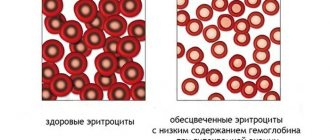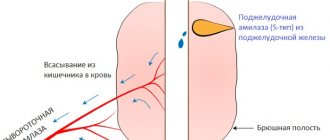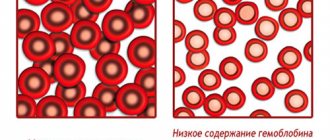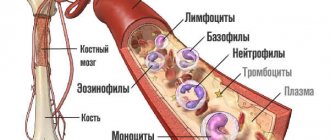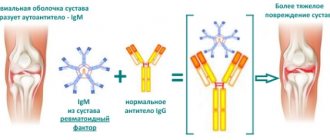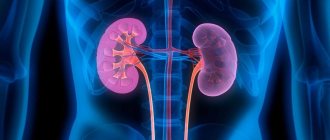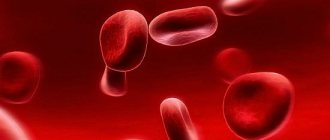Advantages of thymol test
When it comes to the liver, every person understands the importance of this organ.
Without its help, it is impossible to imagine the full functioning of the body . Therefore, it is so important to periodically undergo preventive examinations and take blood tests. It is the thymol test that is most often the main indicator of the quality of liver functioning.
Other advantages of this analysis include the following:
- does not require the use of expensive or complex equipment, material costs are insignificant;
- characterized by simplicity of execution;
- allows you to identify many ailments at an early stage, avoid complications and even death;
- can be used as a kind of indicator of ongoing therapy.
Modern medicine offers a wide range of different diagnostic tests. Among all the diversity, a special place belongs to the thymol sample. It is one of the main tests that detect pathological liver disorders.
What to do if the sample is elevated
So, now we know what an increase in the thymol reaction indicates. Another question is what to do if the sample is too high? Since this study in most cases determines the presence of pathologies of various types, both mild and severe, the obvious solution for the patient would be to undergo a more detailed medical examination, which will help to find out the exact diagnosis and determine a further plan of action. It is possible that complex treatment will be required.
In addition, the thymol test can be used to assess the benefit of existing treatment. For example, if a patient has begun treatment for hepatitis A, then the biochemical analysis method in question, prescribed to the patient every time after a certain period of time, can show how effectively the treatment is going. An alcohol solution of thymol reacts better to destructured liver proteins than other solutions used in medicine.
Now the most promising direction of the thymol test is diagnosing the body for the detection of liver diseases, since it is in this area that this technique shows itself best.
Reasons for the increase
The greatest diagnostic value of the thymol test is manifested in identifying an acute form of viral hepatitis. A positive result is recognized as a marker of this disease.
The McLagan test is the first to respond to the multiplication of the virus in the liver, during a period when there is no jaundice, changes in other liver tests, and an increase in bilirubin concentration.
A violation of the protein composition of the blood caused by other reasons also leads to a positive test result. This is due to the fact that the liver reacts to inflammation and tissue destruction of any location. In the presence of such processes in the body, the relative content of albumin decreases, since globulins for the immune response begin to be intensively synthesized.
The loss of albumin in the urine in kidney disease can change the ratio of blood proteins. Thymol test is at the level of 3 - 4 units. M and with an increase in the level of lipoproteins in the blood. Diseases associated with an elevated Maclagan test include:
- cirrhosis of the liver;
- toxic (including medicinal), infectious, autoimmune hepatitis;
- viral infections, including HIV;
- neoplasms in the liver or beyond with metastases;
- chronic alcoholism (especially when consuming surrogate drinks);
- fatty liver degeneration (steatosis);
- glomerulonephritis, nephrotic syndrome;
- acute pancreatitis, enterocolitis;
- hereditary disorders of the ratio of protein fractions (dysproteinemia);
- multiple myeloma;
- malaria, typhoid fever, mononucleosis;
- autoimmune diseases.
Thymol test is elevated - reasons
To assess the producing properties of the liver, a thymol test is prescribed. Using this analysis, you can find out the ratio of all five protein fractions that this organ produces. Considering that the liver is responsible for the processes of hematopoiesis, metabolism, and hormone balance, you should worry if the thymol test is elevated - the reasons for this result lie in the development of various internal diseases.
Causes of elevated thymol test
The abnormality in question in the biochemical blood test is called dysproteinemia. Its causes are considered to be:
- toxic, alcoholic, viral, drug-induced hepatitis;
- fatty infiltration of the liver;
- Bekhterev's disease;
- glomerulonephritis;
- cirrhosis of the liver;
- amyloidosis;
- Goodpasture's syndrome;
- genetic disorders of protein metabolism;
- liver cancer;
- cryoglobulinemia;
- periarteritis nodosa;
- pyelonephritis;
- brucellosis;
- malaria;
- hemorrhagic vasculitis;
- leptospirosis;
- Wegener's granulomatosis;
- systemic lupus erythematosus;
- multiple myeloma;
- long-term and uncontrolled use of oral contraceptives, steroid hormones;
- mononucleosis;
- macroglobulinemia;
- dermatomyositis;
- pancreatitis;
- Sjögren's disease;
- rheumatoid polyarthritis;
- obstructive jaundice;
- enteritis with severe diarrhea;
- malignant tumors;
- Horton's disease.
In addition, the reasons for an increased thymol test may be a violation of the diet, namely, the consumption of excess fat. Therefore, to clarify the diagnosis, additional laboratory and x-ray studies should be performed.
Increased thymol test in the blood - causes and treatment of this condition
As can be seen, the factors contributing to
increasing the described indicator of liver function, very much. Therefore, it is possible to normalize the value of the thymol test only after establishing the exact cause of the disorder. Depending on the identified disease, a comprehensive therapeutic regimen is drawn up.
Among the prescriptions common to all pathologies, adherence to a special diet is required. The diet involves strict limitation of fats, both animal and plant origin. It is also necessary to practically abandon the consumption of so-called “fast” carbohydrates, sour fruits and vegetables, especially citrus fruits and tomatoes, meat and fish soups, and broths.
WomanAdvice.ru
Sample preparation and conduction
During the day, you need to completely eliminate fatty foods, fried and spicy foods, and alcohol from your diet. In the evening, you need a light dinner, and then a break of at least 8-10 hours between meals. On the morning of the test, you can drink only clean drinking water. Juice, tea or coffee, and carbonated drinks can skew the results. Blood for analysis is given only in the morning on an empty stomach.
A vein puncture (ulnar, hand) is performed in the manipulation room. About 5 ml of blood is drawn into a sterile tube, then labeled and sent to the laboratory for testing. Addition of an anticoagulant is not required. After separating the serum, it is mixed with veronal buffer and concentrated thymol. The result is assessed after half an hour.
With intense turbidity of the solution, the formation of globulin + thymol + lipids complexes occurs.
After this, the laboratory technician compares the degree of change in the transparency of the material with the calibration graph (photocolorimetric method). With a decrease in albumin and an increase in globulins and lipoproteins, the thymol test becomes positive.
When a patient is referred for urgent diagnostics, the result can be obtained within an hour. If a routine examination is carried out, the answer is issued on the same day or the next.
Thymol test norm and diagnostic value
For a number of diseases, sediment samples are used for diagnostic purposes. One of them is the thymol test, proposed in 1944 by McLagan. It is based on changes in the colloidal stability of serum proteins in diseases accompanied by dysproteinemia.
Normally, blood proteins are in a state of high stability. When the ratio of albumin and globulin fractions changes, the colloidal stability of proteins decreases. The lower it is, the more proteins precipitate and precipitate when the thymol reagent is added.
When carrying out the test, an alcohol solution of thymol in veronal buffer or Tris buffer is used as a reagent. The chemistry of the reaction is not completely clear. However, the thymol test clearly correlates with the clinical picture of diseases occurring with dysproteinemia. It is simple to perform and not labor-intensive, so it continues to be widely used when conducting biochemical blood tests.
When performing a test, the patient’s serum is added to the saline solution, then the reagent is added. If normally the thymol test is accompanied by a very slight loss of protein flakes and a slight clouding of the reaction mixture, then in the case of dysproteinemia the solution becomes significantly cloudy. The degree of turbidity depends on the degree of disruption of the colloidal properties of proteins. The test result increases with a decrease in albumin and an increase in beta and gamma globulins.
The degree of turbidity is measured using a biochemical analyzer or photoelectrocolorimeter. Barium chloride of a certain concentration is used as a standard solution.
This study is of particular clinical significance for hepatitis, collagenosis and other diseases accompanied by disproteinemia - a violation of the ratio of serum proteins. Liver damage due to hepatitis is characterized by an increased thymol test. Its norm is from 0 to 4 units. With hepatitis, it becomes positive a week before jaundice. In some cases, the sample increases to 20 or more units. With such high values, it is necessary to repeat the test with the patient’s serum diluted 1:1 and increase the result by 2 times.
Hemolyzed serum is not suitable for testing. During hemolysis, the destruction of red blood cells, it turns red. In this case, the sample will be overestimated. The analysis must be repeated after a new blood draw from a vein.
The thymol test is overestimated if the serum is lipemic (chylous), cloudy due to the presence of lipids (chylomicrons) in it. A laboratory technician, when conducting a test with such serum, should, instead of monitoring with saline solution, make a control with the patient’s serum diluted with saline solution.
To avoid frailty, blood for biochemical studies must be donated strictly on an empty stomach. It must be delivered to the laboratory no later than 2 hours after blood collection. When stored in the refrigerator, the serum is suitable for testing for no more than 7 days.
What does an elevated thymol test mean? Its interpretation is as follows: if it significantly exceeds the norm, you can think about liver disease (hepatitis or cirrhosis), kidney disease occurring with nephrotic syndrome, systemic diseases such as rheumatism, rheumatoid polyarthritis, scleroderma. It is impossible to make a diagnosis based on one indicator. The thymol test should be evaluated in conjunction with other studies. If liver disease is suspected, at least biochemical tests must be done at the same time for the level of total and direct bilirubin, transaminases, cholesterol, alkaline phosphatase, zinc sulfate or mercuric chloride test.
Good health to you!
fb.ru
What to do if you have an elevated thymol test
If you have been informed that there is an elevated thymol test, it is likely that violations are occurring. The doctor’s task is to determine exactly where the deviations are and begin therapy as quickly as possible. The selection of drugs will be carried out depending on the disease that is progressing. If the test is elevated due to kidney disease, the following is prescribed:
- Ciprofloxacin.
- Levofloxacin.
- Maxifloxacin.
- Sulfadimezin.
- Lidaprim.
- Amoxicillin.
- Ampicillin.
If the pathology is caused by rheumatoid abnormalities, the drugs Azithromycin, Bicillin-5, Amoxicillin, Ampicillin, Midecamycin, Clarithromycin, Roxithromycin, Erythromycin, Oxacillin can be prescribed. Disturbances in the gastrointestinal tract are eliminated by taking Phosphalugel, Almagel, Ranitidine, Famotidine, Pancreatin, Creon and Mezim.
In the treatment of liver disorders, the types of hepatitis are taken into account. The most commonly prescribed are Triampur, Furosemide, Ethacrynic acid, Alfaferon, Virazol, Heptral, Gepabene, Heptsinate, Laferon, etc.
If oncological neoplasms occur, then additional diagnostics are carried out, treatment with chemotherapy drugs and possibly surgery are prescribed.
It should be noted that all of the above drugs have a set of contraindications, so you should not buy them yourself. They should be prescribed by a doctor based on your test results.
The liver performs one of the main functions in the human body, and despite the fact that it can regenerate damaged parts, the liver, no less than other organs, needs constant care and attention. When a person is sick, he is provided with optimal conditions for his recovery, the same must be done for his body by reducing the load on it.
https://youtube.com/watch?v=y7mzBCFzILw
https://youtube.com/watch?v=y7mzBCFzILw
Try to supplement your diet with vitamin-containing foods, avoid heavy and fatty foods, and spend more time outdoors. Try to seek medical help at the first symptoms of abnormalities in the functioning of this organ. Simple prevention methods will keep your liver healthy for a long time.
What does the thymol test indicate?
This norm can be either positive or negative. In addition, doctors prescribe monitoring of this analysis to assess changes in protein sediment. This is how the quality of treatment is assessed and possible changes are made if necessary.
The test is positive in the following cases:
- viral hepatitis A, B, C;
- toxic diseases of the liver and biliary tract;
- cirrhosis;
- scleroderma;
- arthritis, inflammatory joint diseases;
- malaria;
- viral infections;
- any formations (both benign and not) in the liver area;
- hormonal liver dysfunction due to exchange therapy or pregnancy prevention;
- kidney diseases (various nephritis);
- inflammation of the pancreas and intestines;
- genetic disorders in the amount of proteins produced by the liver;
- atherosclerosis (lipid metabolism disorder, for various reasons).
As you can see, thymol analysis allows you to detect very serious diseases, prescribe therapy in a timely manner, and even save the patient’s life.
The test is negative if:
- obstructive jaundice due to obstruction of bile outflow;
- rheumatic diseases.
A change in results towards an increase indicates a deterioration in the patient’s condition, while a decrease indicates that therapy gives positive results.
Exceeding standard indicators
An increase in indicators usually indicates developed dysproteinemia. This condition is characterized by a change in the structure of the serum at the protein level. At the same time, its qualitative characteristics are affected. These elements are expressed in 5 fractions. Each of them differs in both chemical and physical properties.
Albumin belongs to the category of the lightest fraction. It is characterized by the ability to maintain a stable state of the so-called colloid blood system. Globulins are slightly larger in mass and tend to precipitate.
A change in equilibrium in the colloidal system and the tendency of proteins toward inevitable coagulation can be caused by such disorders as:
- Reduction in the number of albumins.
- Increased concentration of alpha globulins.
- The presence of paraglobulins in the blood (they should be absent in a healthy person).
If there are significant malfunctions in its functioning, a change in blood characteristics is observed, and the thymol test shows an excess of certain parameters.
On the other hand, a positive test response is possible with extensive skin burns. Exceeding the globulin fraction is also diagnosed in infectious processes, autoimmune disorders and rheumatoid disorders.
Interpretation of the thymol test
It is worth remembering that this analysis only confirms or denies quantitative or qualitative disorders of the protein composition of the blood.
The interpretation is quite simple. In cases where the protein composition of the blood serum is not disturbed, the result of the specified biochemical study is negative and is no more than 5 units (with dysproteinemia, this figure is higher).
Although there are many diseases that are accompanied by
positive thymol test, it has the greatest diagnostic value for the early detection of hepatitis, since in the primary stages of this disease there is no jaundice, and the level of bilirubin and aminotransferases may be within normal limits.
An important feature is that if children have hepatitis A, the thymol test always gives positive results, but with type B hepatitis this indicator does not exceed the established norms. A positive thymol test may indicate previous hepatitis and allows one to draw conclusions regarding the dynamics of recovery processes in the liver, therefore, to clarify the diagnosis, it is recommended to conduct a serological blood test
An important differential diagnostic criterion is also the pattern that in 75% of cases of obstructive jaundice in adults, the test results are negative. They become positive only when the pathological process is complicated by parenchymal inflammation of the liver.
When assessing the results, it should be remembered that the norm of the thymol test depends on age, weight and other factors (for example, on the content of alpha and gamma globulins, as well as on the inhibitory ability of beta lipoproteins). The timing of the analysis is also important (you need to draw blood in the morning strictly on an empty stomach into a special vacuum system without anticoagulants). When deciphering the data obtained, it must be taken into account that taking hepatotoxic pharmacological agents can affect the examination result, and the norm in women may deviate slightly due to the use of oral contraceptives.
It must be said that, despite the availability of more modern diagnostic methods (for example, electrophoresis or immunological tests), the thymol test continues to be widely used in medical practice, which allows for the timely detection and treatment of a significant number of severe pathologies of both the liver and other organs.
We recommend reading: https://www.infmedserv.ru
Who is prescribed a thymol test?
The McLagan test is prescribed if there are certain indications for it. We are talking about liver pathologies: hepatitis (usually viral), drug toxicosis, alcohol poisoning and other liver pathologies.
Important! The thymoloveronal reaction is used not only for diagnosing liver dysfunction. It is successfully used to detect diseases of the heart, gastrointestinal tract, kidneys and other organs.
The analysis can also be prescribed in case of malfunctions in other body systems, which are characterized by an increase in the indicator. These include people who are sick:
- rheumatoid arthritis,
- chronic inflammatory diseases of the spine and joints,
- lupus erythematosus (autoimmune lesions of connective tissues and capillaries),
- pancreatitis,
- kidney diseases,
- oncology.
The thymol clouding technique is also used to monitor the restoration of function and regeneration of liver tissue based on the results of therapy. The rate remains above normal for six months after hepatitis.
Indications for determination
Your doctor may recommend testing if you have signs of viral hepatitis. This disease in its initial stage is very similar to a cold:
- temperature increase;
- sore throat;
- slight cough;
- headache;
- general weakness;
- muscle and joint pain;
- nausea, vomiting;
- bloating, feeling of heaviness in the abdomen;
- unpleasant or bitter taste in the mouth.
The study is indicated for patients without clinical manifestations if:
- contact with a patient with viral hepatitis;
- autoimmune diseases (dermatomyositis, lupus, scleroderma);
- alcoholism;
- cytomegalovirus or herpes infection;
- undiagnosed liver disease in the past (shows changes over a year after viral hepatitis);
- working with toxic and chemical substances;
- malaria, tuberculosis;
- signs of changes in the structure of the liver on ultrasound;
- long-term chemotherapy.
What does the thymol test show?
The site juxtra.info is dedicated primarily to diseases of the digestive system.
Among the objectives of this site is to provide the reader who does not have a special education with accessible, but at the same time reliable information in the field of gastroenterology, and also to warn against thoughtless experiments on one’s health, which are called for by numerous unprofessional publications.
The materials on the site do not at all pretend to be encyclopedic in the field of gastroenterology. The content of each article is determined primarily by the practical interest of readers. So far, only diseases of the biliary system have been covered with sufficient completeness.
Is it possible to remove stones from the gallbladder without surgery?
Removing stones from the gallbladder through natural pathways has been practiced by traditional medicine since ancient times and among many peoples. There are many followers of this practice today.
Of course, the opportunity to get rid of stones without the help of a surgeon is very attractive. And yet, since health is at stake, you should carefully understand everything.
What are the methods for expelling gallstones based on?
Gallbladder
The gallbladder is a hollow pear-shaped sac-like formation located in the abdominal cavity in the right hypochondrium under the lower surface of the liver.
At the exit from the gallbladder there is the Lutkens sphincter - a muscular thickening that has approximately the same purpose as a water tap: to shut off the duct if necessary.
A healthy gallbladder cannot be felt through the abdominal wall. This is possible only with a significant increase in it, and only not with inhalation; palpation is often accompanied by pain (Murphy's symptom).
Gallstones and gallstone disease
Another interesting observation: on the African continent, gallstones are quite rare (only 3-4%), but blacks in the United States suffer from gallstones even more often than the white population. The influence of the nutrition factor here is obvious. The incidence of gallstone disease is lowest in China and the countries of Southeast Asia (2-3%), which is also apparently associated with dietary traditions.
Unfortunately, the Russian Federation and Ukraine, with the prevalence of this disease up to 12-15%, are also among the leaders. Every year, 600 thousand gallbladder removal operations are performed in the Russian Federation, and 1.2 million in the USA.
Cholecystitis
Infection is found in most cases of acute cholecystitis. Its role in the development of cholecystitis is often secondary. Conditions for the development of infection are created by stagnation of bile in the bladder when the cystic duct is blocked. The predominant microorganisms are Escherichia coli, streptococci, staphylococci, enterococci, Klebsiella, and less commonly bacteroides and clostridia.
What does the thymol test show?
Blood proteins regulate blood acidity, its oncotic pressure, immune reactions, form cholesterol and bilirubin transport complexes, transport iron ions, a number of hormones, and medications. Albumin and partially globulins are synthesized by the liver. If its functions are impaired, then the following changes:
- ratio of protein fractions (albumin decreases);
- the configuration of the molecule, its mass and charge;
- resistance to settling (colloidal stability).
As a result, proteins combine into complexes and precipitate. This loss of stability of the protein part of the blood is the basis of the thymol test. It is not specific, as it becomes positive in many liver lesions.
The test is used infrequently, because there are more modern methods for studying the function of liver cells (alkaline phosphatase, ALT, AST, bilirubin, prothrombin index). Nevertheless, the McLagan test can help in differential diagnosis and assessment of the severity of hepatitis damage and the effectiveness of therapy.
Violation in the protein ratio is the basis of the thymol test
In cases of damage to the liver parenchyma, a decrease in the albumin fraction contributes to easier precipitation of the globulin fraction. Changes in the physicochemical properties of blood plasma proteins in various liver diseases are the basis for diagnostic sediment reactions, for example, the thymol test and the Veltman test.
The thymol test, having a fairly high sensitivity, gives a positive result (up to 100%) in acute hepatitis, but its special value lies in the fact that a positive reaction is detected even in the pre-icteric period, as well as in anicteric forms of the disease (for example, in cases of hepatitis C , which is characterized by an easy opening).
Thus, the main characteristics of the test being studied can be presented as follows:
- Thymol test values are expressed in Shank-Hoaland thymol turbidity units (SH units) or Maclagan units (M units);
- Normal values for thymol test results are in the range of 0 – 4 SH units (some laboratories give the norm up to 5 SH units);
- The normal levels of thymol test indicators in women and men do not differ - in a healthy body, albumins, being in normal concentrations, ensure the stability of globulins, therefore the studied indicator, regardless of gender, will not exceed the normal limit.
Meanwhile, in women who are young and healthy, but who use oral contraceptives, the thymol test can still be elevated. This is because these drugs affect the functional abilities of the liver, as a result of which the ratio of serum proteins changes, and, therefore, the values of this coagulation test increase.
In children, the values of normal indicators are also in the range of 0 - 4 SH units , however, with hepatitis A, which is more often “caught” by primary schoolchildren and adolescents, the thymol test is increased already at the initial stage of the development of the disease, when even the slightest signs of jaundice are absent.
Treatment of abnormalities
Treatment is prescribed taking into account the cause of liver dysfunction. To restore it you need:
- restriction of physical activity during exacerbation;
- minimum amount of medications;
- exclusion of alcohol, fatty and fried foods;
- sharp limitation of canned food, smoked foods, marinades, hot sauces, spices and strong coffee, tea;
- ensure the supply of proteins from lean meat, dairy and fish products;
- include boiled vegetables and non-acidic fruits in the menu.
To protect liver cells, a group of drugs called hepatoprotectors is used. These drugs prevent the destruction of hepatocyte membranes and accelerate the processes of restoration of albumin synthesis. They are usually prescribed in courses of 2-3 months at least twice a year. The most effective are Essentiale Forte N, Heptral, Glutargin, Hepa-merz, Gepadif.
For viral hepatitis, interferon is administered intramuscularly or intravenously in combination with antiviral drugs (ribavirin), and new long-acting interferons (pegylated) are also used - Pegasys, Algeron. If hepatitis is caused by an autoimmune process, then hormonal therapy is indicated.
The thymol test is highly sensitive to liver destruction, especially with viral hepatitis A. It helps to detect it at the preclinical stage. A positive result also occurs in infectious, autoimmune, and tumor processes in the body. It is fast and recommended for monitoring treatment. If there is a deviation from the norm, additional examination and mandatory treatment and diet are indicated.
When results improve
In various liver diseases, attention is always drawn to a decrease in the albumin fraction, which is associated with a violation of their synthesis, and an increase in the gamma and beta globulin fractions. This occurs because albumin is synthesized directly in liver cells, and the affected parenchyma is not able to provide normal levels of albumin
The simultaneous increase in globulin fractions (with a decrease in albumin concentration) is explained by the fact that other components - cells included in the tissue macrophage system - are predominantly responsible for the production of these proteins.
The main reasons causing an elevated thymol test are liver diseases accompanied by damage to its parenchyma:
- Infectious and viral hepatitis;
- Neoplasms localized in the liver;
- Damage to the liver parenchyma by alcohol and, especially, its surrogates;
- Toxic effects of various poisons, heavy metals and some medications;
- Cirrhosis of the liver;
- Fatty degeneration of liver tissue (fatty hepatosis) – accumulation of fat in hepatocytes (liver cells);
- Functional disorders caused by long-term use of oral contraceptives and other hormonal drugs.
However, regarding the liver, it should be noted that obstructive jaundice, although frightening with its external manifestations, in itself does not expand the boundaries of thymol turbidity. This test will be increased only if liver tissue is involved in the pathological process and parenchymal hepatitis develops.
Other causes of increased thymol test:
- Severe kidney pathology (amyloidosis, pyelo- or glomerulonephritis), in which a large amount of protein is constantly excreted in the urine;
- Diseases of the gastrointestinal tract (pancreatitis, enteritis with severe diarrhea);
- Tumor processes of benign and malignant nature of various localizations;
- Pathological conditions caused by viral infection;
- Hereditary dysproteinemia (violation of the ratio of serum proteins);
- Myeloma;
- Systemic diseases (SLE - systemic lupus erythematosus, rheumatoid polyarthritis, dermatomyositis);
- Septic endocarditis (with rheumatism, the test is not elevated, it remains within normal limits);
- Malaria.
The thymol test can be elevated even in the absence of illness - for example, if a person is overly fond of fatty foods. In this case, prosperity will also not last indefinitely. Another problem will arise - increased cholesterol, a change in the lipid spectrum... Low-density lipoproteins accumulated in the blood will begin to be deposited on the walls of blood vessels, forming atherosclerotic plaques, which, in turn, will give rise to a pathological process such as atherosclerosis. That is, a constantly elevated thymol test and the absence of clinical manifestations of the disease indicate that an urgent need to change the diet.
Reasons for exceeding the norm
Previously, if the test result deviated from the norm, only liver disease was diagnosed. After some time, it was discovered that such data could be obtained for other ailments. Nowadays, if the thymol test is elevated, the reasons may be as follows. In the patient:
- Liver disease develops.
- Kidney disease. Albumin protein is lost and is excreted in the urine. Diseases such as pyelonephritis, glomerulonephritis, and amyloidosis occur.
- Protein metabolism disorder associated with heredity.
- Rheumatoid pathology.
- Diseases of the digestive system.
- Malignant formations.
- Multiple myeloma.
In addition to all of the above, the thymol test may be elevated if the patient eats fatty foods in large quantities. In this case, you need to pay attention to other biochemical indicators.
In case of liver pathology, you should definitely pay attention to bilirubin, cholesterol, alkaline phosphatase and the result of the sublimate test.
Short description
To understand what kind of analysis this is, you need to understand its essence. The main part of the proteins in the blood is formed in the liver elements. They are responsible for many variable tasks:
- active participation in the regulation of blood clotting;
- maintaining oncotic pressure and ensuring the volume of the main body fluid;
- maintaining blood pH;
- transportation to tissues of certain categories of elements (for example, cholesterol).
Blood serum has a varied composition. However, only 5 protein fractions are considered important components. These are various globulins.
Under the influence of certain factors, their number may decrease or increase. For example, against the background of liver dysfunction or poor nutrition, the number of albumins decreases sharply. An increase in globulins occurs in pathologies of connective tissue, infectious processes of various etiologies, and some oncological diseases.
The thymol test is usually understood as a special biochemical study. It allows you to obtain information about the liver’s ability to carry out complete synthesis of protein fractions.
The principle of laboratory research is reduced to the precipitation of whey proteins. If cloudiness of the substance is observed, the test result is said to be positive. The degree of change in the appearance of the material is determined by the photocolorimetric method, and is expressed in the so-called Maclagan units (M units).
The physicochemical characteristics of this analysis remain poorly understood. However, scientists claim that when carrying out the reaction, complex complexes of phospholipids and globulins, thymol, and cholesterol are possible.
How to donate blood correctly
It is recommended to carry out a blood test in the morning. Approximately 8 hours before the intended procedure, it is better to follow a fasting diet. You are allowed to drink only regular still water. You should not drink strong coffee or tea or juices in large quantities.
Thymol test: description of the procedure
Features and benefits of the test
The thymol test is a biochemical test that makes it possible to assess the synthesizing ability of the child’s liver.
It is this organ that is the site of the production of large amounts of blood plasma proteins, which perform vital functions in the body of children:
- Maintains correct oncotic blood pressure
- Affect blood clotting
- Maintains blood pH at the required level
- Participate in the transfer of certain types of compounds to organs and tissues
Modern medicine identifies 5 types of proteins that may be present in the body of children. It is the thymol test that can determine their ratio and thus identify various types of disease at the earliest stages even before the manifestation of its characteristic symptoms.
Such a laboratory test is based on the precipitation of serum proteins and when it becomes cloudy, we can talk about a positive result.
To conduct the study, blood is drawn early in the morning on an empty stomach. To obtain accurate and reliable results of the procedure, you must be 8-10 hours before the test from eating. If your child gets thirsty, you can give him some water, but avoid drinking tea or juices.
Recommendations
In some forms of disease, the indicator may remain unchanged. However, in children this analysis usually requires more attention. Because, for example, with the progression of hepatitis A in children, the norm is exceeded, but with hepatitis B, the thymol test gives normal results. It is also possible to increase the serum protein reaction after the child has had hepatitis. For these reasons, it is always recommended to carry out additional diagnostics: one thymol test can lead down the wrong diagnostic path.
For preventive purposes, the described examination is not carried out, since it is not classified as a standard biochemical blood test. However, if there are indications for research, then many specialists, despite the capabilities of modern medicine, in the form of immunological and other tests, still give preference in the old-fashioned way to the thymol test, since the result of this type of diagnosis makes it possible to detect the disease in time and begin to treat it, avoiding complications .
Advantages of the method
An important advantage of the thymoloveronal test is its high sensitivity. It helps to make a diagnosis even before the appearance of the main symptom of hepatitis - jaundice.
The McLagan test responds to liver damage earlier than others. This allows you to identify the disease at the initial stage, prescribe therapy and prevent the destruction of liver tissue and the spread of viral infection.
The thymol test is also used to distinguish between mechanical blockage of the bile ducts and liver damage. In both cases, the symptoms are similar, but jaundice when obstructing the flow of bile rarely gives a positive result.
The analysis is also carried out to monitor the effect of treatment. It can be prescribed repeatedly, since the thymol test does not require lengthy preparation or financial costs. There are no contraindications for its use.
Watch the video about AST and ALT blood tests:
What is a thymol test, its role in a biochemical blood test
In practice, Maclagan test indicators are always accompanied by obtaining information about the concentration of bilirubin and enzymes (transaminases - AlT, AST, alkaline phosphatase) to identify liver dysfunction. What does the thymol test show?
This analysis reveals an atypical reaction of gamma and beta globulins (as well as LDL) to thymol in veronal buffer, which manifests itself as precipitation and turbidity of the solution. This process is characteristic of a reduced concentration of albumins, synthesized directly by the liver parenchyma, against the background of an increased content of globulins, which are produced in tissue macrophages. In the thymoloveronal test, the turbidity of the solution is assessed using an electric photocolorimeter.
The decoding of Maclagan's test is the production of complex compounds of the globulin-thymololipid type during the reaction, where 40% are globulins, 32% are thymol, 18% are cholesterol and 10% are phospholipids. A change in these values in any direction indicates the inability of the liver to synthesize proteins for blood plasma. Therefore, a positive test result, based on the rapid sedimentation of less heavy globulins, may indicate damage to the liver parenchyma.
What is a thymol test?
The normal thymol test, which indicates the full health of the liver, is, as a rule, not a separate analysis and is in addition to bilirubin and blood enzymes such as alkaline phosphatase and transaminases. The thymol test in children makes it possible to detect hepatitis A at an early stage, and in adult men and women it makes it possible to promptly recognize abnormalities in the functioning of the heart, kidneys and gastrointestinal tract.
A thymol test in a child allows one to detect hepatitis even before the icteric state. Such a quick result cannot be achieved using other diagnostic methods, which is why this analysis, although outdated, is not in a hurry to be discarded in scientific laboratories.
The main advantage of this analysis is that it does not require additional equipment; all the reagents necessary for the study can be prepared by a laboratory assistant in a magnetic stirrer and fume hood. The test results can easily be read using an electrospectrophotometer, which is available in every laboratory. Deciphering the results at an early stage allows you to avoid complications that can be caused by a protracted inflammatory process in the internal organ. This analysis can be used not only as a diagnostic procedure, but also used to monitor the processes of restoration of liver tissue during the use of therapeutic therapy.
If we talk about the test itself, the method of taking blood is no different from taking a biochemical analysis. Blood is withdrawn from a peripheral vein on an empty stomach. Before donating blood, you should not drink soda or coffee, and three hours before donating, you should stop taking medications. If you have chronic diseases, then you need to consult with your doctor; he will tell you which medications are best to avoid and which ones will not affect the reliability of the results.
Blood taken from the patient is sent into a test tube and then sent to the laboratory for testing. There, the diagnosis will be as follows: 6 ml of veronal-medinal buffer solution and a saturated solution of thymol are added to the serum. The resulting liquid is left for half an hour. After the specified time, the intensity of turbidity of the solution is assessed using the photocolorimetric method. The severity of turbidity indicates the presence of pathological processes in the body. It is believed that the test is positive if the amount of albumin in the serum decreases, and the concentration of β-globulins, γ-globulins and lipoproteins increases.
Analysis mechanism
You should know that a blood test - a thymol test - is taken on an empty stomach, early in the morning. Drinking food, coffee, tea, and juice should stop eight hours before the procedure. You are allowed to drink a small amount of water. Try to adhere to these rules, as the result obtained and the correctness of the diagnosis depend on them.
Now about the mechanism:
- Take six milliliters of veronal-medinal buffer solution. Its acidity should be seven point eight.
- To it add zero point one tenth of a milliliter of blood serum plus a saturated solution of thymol.
- The resulting mixture is left for thirty minutes.
- After this, using the photocolorimetric method, the degree of turbidity is determined.
This result is also influenced by the conditions under which the analysis was carried out. These include: the nature of the buffer solution, its acidity and concentration, as well as the degree of purity and temperature of thymol.
Standard indicators
The initial decoding of the sample is quite simple:
- If the analysis column contains 0–5 units, it should be considered negative. Such indicators indicate that there are no serious violations in the composition of the serum.
- When the result is more than 5 units, the test is considered positive. The norm for men, women and children is the same.
Decoding test results
As a rule, deciphering a sample does not cause any particular difficulties for qualified physicians. If the protein component of the serum is not accompanied by any serious changes, the result is said to be negative. In this case, the sample indicator should be less than 5 units.
A positive answer often indicates developing hepatitis. It is noteworthy that through this analysis it is possible to diagnose this serious illness even before its primary manifestations occur. A positive test is also possible when bilirubin and aminotransferases remain within the normal range.
The thymol test norm in children may be exceeded if they were previously diagnosed with hepatitis A. Group B pathology is rarely accompanied by an increase in the indicator relative to the norms accepted in medicine.
A positive test sometimes indicates that the young patient has already had hepatitis before. In this case, the test is considered a kind of beacon of the dynamics of normalization of liver function.
If obstructive jaundice progresses in an adult, the responses to the thymol test are most often negative. However, if complications occur in the form of parenchymal inflammation, the results may change.
When assessing a sample test, a specialist should not forget that standard indicators are determined by the following parameters: the patient’s age, his approximate weight, time of diagnosis
When deciphering the test, you also need to take into account that its parameters may be affected by some pharmaceuticals
Despite the possible errors, the thymol test is even today considered one of the most informative studies. You have to resort to his help quite often. The thing is that it allows you to diagnose disorders in the liver at the initial stages and select competent therapy.
Probable diseases
Several years ago, the main reasons for an increase in thymol test were considered solely from the point of view of liver dysfunction. Today, the opinions of scientists have changed dramatically. Now experts identify a number of diseases, the development of which accompanies the state of dysproteinemia.
Among them, the following are especially worth noting:
- Kidney dysfunction, characterized by loss of albumin protein through urine.
- Liver pathologies that manifest themselves as cirrhosis, hepatitis or neoplasms.
- Systemic rheumatoid diseases.
- Diseases of the gastrointestinal tract system.
- The presence of neoplasms of malignant etiology.
The thymol test is sometimes elevated due to poor nutrition. As a rule, this problem is diagnosed in women. Abuse of excessively fatty foods can lead to changes in indicators
This is why it is important to take into account other blood test options during a diagnostic examination.
